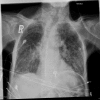Middle East respiratory syndrome coronavirus: a case-control study of hospitalized patients
- PMID: 24723278
- PMCID: PMC7108071
- DOI: 10.1093/cid/ciu226
Middle East respiratory syndrome coronavirus: a case-control study of hospitalized patients
Abstract
Background: There is a paucity of data regarding the differentiating characteristics of patients with laboratory-confirmed and those negative for Middle East respiratory syndrome coronavirus (MERS-CoV).
Methods: This is a hospital-based case-control study comparing MERS-CoV-positive patients (cases) with MERS-CoV-negative controls.
Results: A total of 17 case patients and 82 controls with a mean age of 60.7 years and 57 years, respectively (P = .553), were included. No statistical differences were observed in relation to sex, the presence of a fever or cough, and the presence of a single or multilobar infiltrate on chest radiography. The case patients were more likely to be overweight than the control group (mean body mass index, 32 vs 27.8; P = .035), to have diabetes mellitus (87% vs 47%; odds ratio [OR], 7.24; P = .015), and to have end-stage renal disease (33% vs 7%; OR, 7; P = .012). At the time of admission, tachypnea (27% vs 60%; OR, 0.24; P = .031) and respiratory distress (15% vs 51%; OR, 0.15; P = .012) were less frequent among case patients. MERS-CoV patients were more likely to have a normal white blood cell count than the control group (82% vs 52%; OR, 4.33; P = .029). Admission chest radiography with interstitial infiltrates was more frequent in case patients than in controls (67% vs 20%; OR, 8.13; P = .001). Case patients were more likely to be admitted to the intensive care unit (53% vs 20%; OR, 4.65; P = .025) and to have a high mortality rate (76% vs 15%; OR, 18.96; P < .001).
Conclusions: Few clinical predictors could enhance the ability to predict which patients with pneumonia would have MERS-CoV. However, further prospective analysis and matched case-control studies may shed light on other predictors of infection.
Keywords: MERS; case-control; coronavirus; radiographic characteristics.
© The Author 2014. Published by Oxford University Press on behalf of the Infectious Diseases Society of America. All rights reserved. For Permissions, please e-mail: journals.permissions@oup.com.
Figures
Similar articles
-
Clinical and Laboratory Findings of Middle East Respiratory Syndrome Coronavirus Infection.Jpn J Infect Dis. 2019 May 23;72(3):160-167. doi: 10.7883/yoken.JJID.2018.187. Epub 2018 Dec 25. Jpn J Infect Dis. 2019. PMID: 30584196
-
Clinical Characteristics and Outcome of Hospitalized COVID-19 Patients in a MERS-CoV Endemic Area.J Epidemiol Glob Health. 2020 Sep;10(3):214-221. doi: 10.2991/jegh.k.200806.002. J Epidemiol Glob Health. 2020. PMID: 32954712 Free PMC article.
-
Clinical and laboratory findings of the first imported case of Middle East respiratory syndrome coronavirus to the United States.Clin Infect Dis. 2014 Dec 1;59(11):1511-8. doi: 10.1093/cid/ciu635. Epub 2014 Aug 6. Clin Infect Dis. 2014. PMID: 25100864 Free PMC article.
-
Middle East respiratory syndrome coronavirus (MERS-CoV): what lessons can we learn?J Hosp Infect. 2015 Nov;91(3):188-96. doi: 10.1016/j.jhin.2015.08.002. Epub 2015 Aug 22. J Hosp Infect. 2015. PMID: 26452615 Free PMC article. Review.
-
[Dromedary camels and Middle East respiratory syndrome: MERS coronavirus in the 'ship of the desert'].Ned Tijdschr Geneeskd. 2014;158:A7806. Ned Tijdschr Geneeskd. 2014. PMID: 25248734 Review. Dutch.
Cited by
-
MERS-CoV: Understanding the Latest Human Coronavirus Threat.Viruses. 2018 Feb 24;10(2):93. doi: 10.3390/v10020093. Viruses. 2018. PMID: 29495250 Free PMC article. Review.
-
SARS-CoV 2 Infection (Covid-19) and Cardiovascular Disease in Africa: Health Care and Socio-Economic Implications.Glob Heart. 2021 Mar 15;16(1):18. doi: 10.5334/gh.829. Glob Heart. 2021. PMID: 33833942 Free PMC article. Review.
-
Severe acute respiratory syndrome coronavirus 2 (SARS-CoV-2) and Middle East Respiratory Syndrome Coronavirus (MERS-CoV) coinfection: A unique case series.Travel Med Infect Dis. 2021 May-Jun;41:102026. doi: 10.1016/j.tmaid.2021.102026. Epub 2021 Mar 13. Travel Med Infect Dis. 2021. PMID: 33727175 Free PMC article.
-
The Comparative Immunological Characteristics of SARS-CoV, MERS-CoV, and SARS-CoV-2 Coronavirus Infections.Front Immunol. 2020 Aug 14;11:2033. doi: 10.3389/fimmu.2020.02033. eCollection 2020. Front Immunol. 2020. PMID: 32922406 Free PMC article. Review.
-
Middle East respiratory syndrome coronavirus: current situation and travel-associated concerns.Front Med. 2016 Jun;10(2):111-9. doi: 10.1007/s11684-016-0446-y. Epub 2016 May 4. Front Med. 2016. PMID: 27146399 Free PMC article. Review.
References
-
- Zaki AM, van Boheemen S, Bestebroer TM, Osterhaus AD, Fouchier RA. Isolation of a novel coronavirus from a man with pneumonia in Saudi Arabia. N Engl J Med. 2012;367:1814–20. - PubMed
-
- Hijawi B, Abdallat M, Sayaydeh A, et al. Novel coronavirus infections in Jordan, April 2012: epidemiological findings from a retrospective investigation. East Mediterr Health J. 2013;19(suppl 1):S12–8. - PubMed
-
- Joint Kingdom of Saudi Arabia/WHO mission. Riyadh, Saudi Arabia: 2013. Middle East respiratory syndrome coronavirus. Available at: http://www.who.int/csr/disease/coronavirus_infections/MERSCov_WHO_KSA_Mi.... Accessed 12 December 2013.
-
- Al-Tawfiq JA, Assiri A, Memish ZA. Middle East respiratory syndrome novel corona MERS-CoV infection. Epidemiology and outcome update. Saudi Med J. 2013;34:991–4. - PubMed
-
- Saudi Ministry of Health—novel coronavirus - media statements. Available at: http://www.moh.gov.sa/en/CoronaNew/PressReleases/Pages/default.aspx . Accessed 20 November 2013.
MeSH terms
LinkOut - more resources
Full Text Sources
Other Literature Sources



